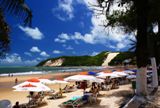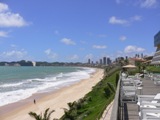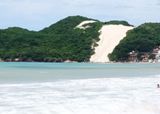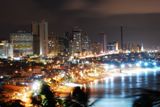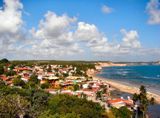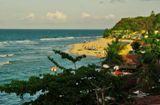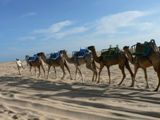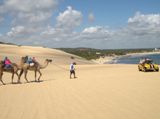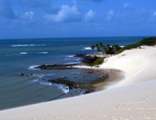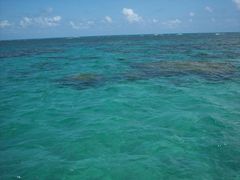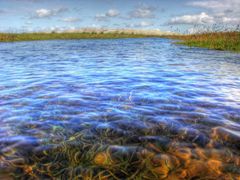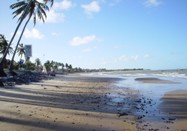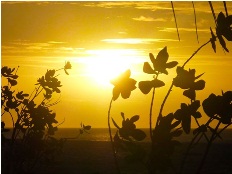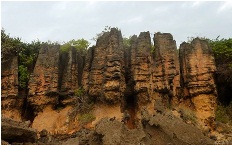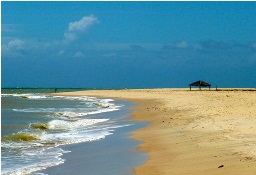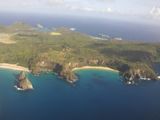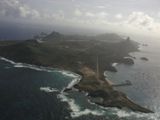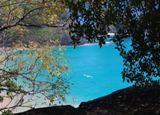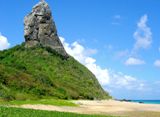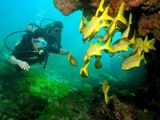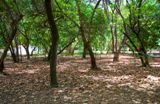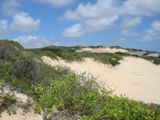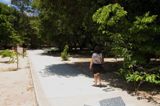BEACHES
Ponta Negra Beach
Location: South Littoral (14km from downtown)
Located in the urban area of Natal, Ponta Negra beach has a downhill of sand that is surrounded by bushes. There you can see the Morro do Careca, one of the city’s most beautiful postcards, with excellent infrastructure of hotels, inns and restaurants. It is 120m high with white moving sand, and it is contemplated by unique vegetation and enriched by a small bay. Ponta Negra It is the place for a lot of night fun. The shore is used by visitors who want to go jogging, have some rest or only chat to friends. It is the first beach on the South Littoral and the first one beginning on Rota do Sol – South Littoral.
Pipa Beach
Location: South Litoral
It is the city’s most agitated beach, considered one of Brazil’s most beautiful 10 beaches. Pipa Beach is actually a complex of beaches (Cacimbinhas, Do Amor Beach, Baia dos Golfinhos etc.). It has a Fishermen Village, Ecologic Hiking around Sea Hills, where there is an ecologic sanctuary, and boat ride.
Genipabu Beach
Location: North Litoral
It takes an area of 1.881 hectares. It is the state’s biggest postcard and on them one can have extreme Buggy rides. In the end of these rides, the visitor can enjoy the wonderful view from Genipabu Lagoon, with wonderful vegetation and blue waters.
Maracajaú Beach
Location: North Litoral
It is known as the Brazilian Caribbean, 7km from the coast. It has a coral formation that during the low tide appears on the surface, forming natural pools of warm and crystalline waters, whose depth varies from 0,5 to 3,0 meters. The Maracajaú Reefs represent a very famous destiny among tourists from many different regions of Brazil and abroad. The ecosystem is totally preserved, and go swimming around the most varied species of the fauna and sea flora is an unforgettable program. Many boats perform rides towards these reefs.
São Miguel do Gostoso Beach
Location: Noth Litoral
Located only 110km north of Natal, you will find São Miguel do Gostoso, one of the most beautiful destinies to visit when you come to Rio Grande do Norte.
Besides the incredible view, São Miguel do Gostoso offers you a variety of high quality hotels and guest houses, with a very cozy atmosphere, as well as restaurants, bars, shops and services.
FERNANDO DE NORONHA
This magnificent place is an archipelago with 21 islands located in the Atlantic ocean.
The archipelago, located 354km offshore from Brazilian coast, it belongs to the state of Pernambuco, however it is closer to Rio Grande do Norte state, where Natal is located.
Fernando de Noronha is a UNESCO World Heritage Site, and one of the main touristic places in Brazil. The best way to go to archipelago is by plane from Natal (360km).
Among the many options, one can mention island tour, boat trip, many trails (including the one that leads to the dolphin observation post), diving and scuba diving.
PARQUE DAS DUNAS
The Parque Estadual Dunas do Natal is the first Unit of Environmental Preservation implemented in Rio Grande do Norte. It occupies and area of about 1.172 hectares.
One of the last dense areas of Mata Atlântica preserved in the State, the Parque das Dunas is considered to be Brazil’s second biggest urban park. Its dunes’ ecosystem is varied, covering a fauna and flora of great bioecological value, which includes many species in process of extinction. That is why it is so important: due to its scientific and paisagistic potential, with facilities for researches, environmental education, leisure and ecological tourism, besides its geologic-geomorphic importance.
From 1993 on, it was considered by UNESCO part of the Brazilian Mata Atlântica Biosphere Reserve, a Humanity Environmental Patrimony.
THE WORLD’S BIGGEST CASHEW TREE
The world’s biggest cashew tree is located in the district of Pirangi do Norte, in Parmamirim – Natal. A secular tree whose crown measures 8.400m2 , unique specimen. The cashew tree was planted in 1888 by a fisherman named Luiz Inácio de Oliveira, who died at the age of 93 under the shadows of the tree. The tree’s growth is explained firstly by saying its branches grew to the sides instead of upwards; with their own weight, the branches tend to reach the ground, touch the soil and create roots, and then, start growing again, as if they were the branches of another tree. This process’ repetition gives the impression there are many cashew trees there, but actually it is the same one: a single tree.
The visit to it is directed by guides who explain the tree’s characteristics (there are bilingual guides, speaking both English and Spanish). Inside the park there is a gazebo about 6 meters high and from where one can see the tree’s crown and the beaches around. During the harvest period, the cashew tree produces around eighty thousand fruits, which can be collected by visitors.



